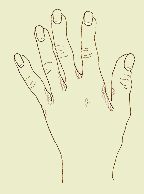


All epoxy products present some degree of hazard in use, with some being more hazardous than others. The most important safety factor in their use is to avoid direct skin or eye contact. We have attempted to make our "POXY-GRIP" and POXY-SHIELD® products as safe as possible, consistent with high physical properties, high value, and ease of use.
The most common adverse affect of working with epoxy products is a possible poison ivy-like rash which can develop. However, this usually occurs only after a long period of time with repeated direct skin contact with the products, resulting from a disregard for safety procedures. Once a sensitivity to epoxy develops, fumes or even sanding dust can cause a rash. Susceptibility to this problem and its intensity varies with the degree of contact, physical differences between individuals, and the state of health of the user. Remember that the effects of epoxies, like other sensitizers, is cumulative. The time to follow safety procedures is when you start, not when a reaction develops.
The resin portions of the products by themselves rarely cause problems, but the hardeners are considered moderate to moderately-strong skin irritants and sensitizers. Thus, all contact with the skin should be avoided. However, once mixed with the resin, this hazard is greatly reduced.
PRIOR TO ANY USE OF THESE PRODUCTS, THE FOLLOWING SAFETY PRECAUTIONS SHOULD BE READ AND UNDERSTOOD:
- 1. Use disposable or durable rubber gloves and apply barrier cream to all exposed portions of the body, including your face. If you believe you may be prone to an allergic reaction we recommend only the sturdier gloves be used. Disposable gloves are only for light use as they frequently tear and they may not be a positive barrier with prolonged use.
- 2. Wear protective clothing, preferably of a non-permeable type (disposable paper or plastic-type aprons and similar apparel are excellent in this regard since cured epoxy cannot be removed from clothing, and most fabrics can be penetrated by uncured epoxy).
- 3. Don't use ketone-based or chlorinated solvents to remove resin from the skin. These products are "de-fatting" agents that remove protective oils from the skin and drive the epoxy into the skin, and they also may be skin irritants in themselves.
- 4. Avoid inhalation of vapors and dust, especially from partially cured or "green" epoxy (total cure may take from 4 to 7 days or longer depending on conditions). Wear a sanding mask whenever dust is present along with protective clothing when sanding coated surfaces that have not cured for at least seven days. Provide adequate and positive ventilation to all enclosed areas, especially within the hull itself, and especially when using solvents.
- 5. Protect eyes by wearing goggles, face mask, or glasses, especially when mixing and working overhead, and especially when working with the more fluid POXY-SHIELD®. lf eye contact occurs, flush IMMEDIATELY with plenty of water for at least 15 minutes and seek immediate medical attention concurrently.
- 6. lf rash develops, stop working with the products until it goes away (3-5 days usually). Do not bandage a rash, and if severe, contact a physician.
- 7. Keep away from children, animals, and anyone not familiar with the use and hazards of the materials.
- 8. lf skin contact occurs, remove material and use waterless hand cleaner or wash IMMEDIATELY with soap and water or other suitable cleanser (see heading, Clean-Up, Solvents, & Thinners).
- 9. Do NOT eat or drink in the area where the products are being used.
- 10. Avoid having any exposed flames or high heat sources in the work area. While our products are considered "non-combustible", they will burn if ignited.
- 11. DO NOT SPRAY ANY EPOXY RESINS.